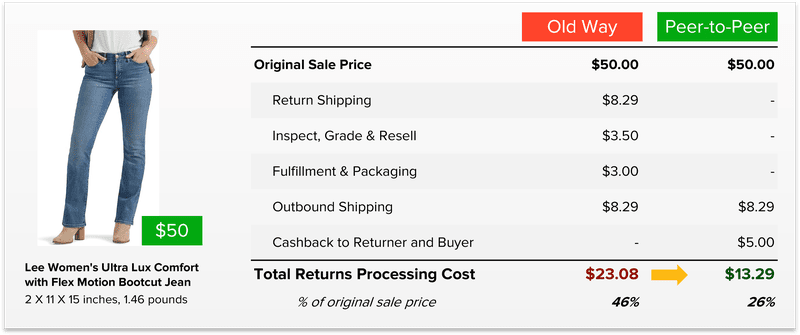How to Reduce Returns: Addressing the Rise of Ecommerce Return Rates | Cahoot

Last updated on February 24, 2025

The rise of ecommerce has revolutionized the retail landscape, offering unparalleled convenience and putting an unlimited selection of products at consumers’ fingertips. However, this boom has also led to a significant increase in return rates, posing challenges for retailers. Returns have significant operational and financial implications for online retailers. High return rates burden ecommerce operations, increasing processing and restocking costs. Understanding the reasons behind this trend and identifying who is most likely to return online orders is crucial for developing effective strategies to mitigate returns.
What is a Return Policy in Ecommerce?
A return policy in ecommerce is a set of guidelines that outlines how customers can return products they are not satisfied with. It is a crucial component of building trust and ensuring customer satisfaction. A well-crafted return policy should clearly state which items are eligible for return, the steps to initiate a return, and what customers can expect during the return process. Additionally, it should specify any fees associated with returns, providing transparency and setting clear expectations. By having a comprehensive return policy, businesses can improve customer experience and foster long-term customer loyalty.
Understanding Ecommerce Returns
Ecommerce returns are an inevitable part of the online shopping experience. Understanding the intricacies of ecommerce returns is essential for businesses aiming to enhance customer satisfaction and streamline their returns process.
Average Return Rate for Ecommerce
The sheer popularity and ease of online shopping have led to a significant increase in the frequency of ecommerce returns. The average return rate for ecommerce varies across different industries and product categories. However, studies indicate that the average return rate for ecommerce hovers around 20-30%. This means that for every 100 products sold, 20-30 are returned. This return rate is at least double the rate observed in brick-and-mortar stores. Companies across industries are grappling with the financial impact of unsustainable return rates. Understanding this average return rate is crucial for ecommerce businesses to effectively plan and manage their returns process. By anticipating return volumes, businesses can allocate resources more efficiently, optimize their reverse logistics, and implement strategies to reduce return rates.
Why are Return Rates so High?
This can be attributed to several key factors. The inability to physically inspect products before purchase makes it more likely that items will not meet customer expectations. Product sizing, quality, and functionality are common pain points leading to returns. Inaccurate product descriptions, poor-quality imagery, and lack of detailed sizing information often result in receiving items that don’t meet customer expectations. Additionally, “wardrobing” – the practice of wearing an item and then returning it – and the similar practice of “bracketing” – where customers intentionally order multiple variations of a single product with the plan to return all but one – have become increasingly common, driven by the convenience of ecommerce.
Certain product categories are more susceptible to high return rates. Apparel, for instance, can see return rates as high as 40% or more as customers struggle to find the right fit without trying items on. Other segments like luxury goods, beauty, and electronics also tend to have elevated return volumes. Ultimately, the anonymity of online shopping compared to in-person experiences contributes significantly to the ecommerce return epidemic.
Fraudulent returns are another growing challenge, with many merchants reporting incidents of thieves taking advantage of lax policies that are meant to encourage customer loyalty by endeavoring to achieve customer satisfaction. This dynamic has forced retailers to implement stricter measures to validate legitimacy and protect profit margins. Meanwhile, consumer expectations around generous, hassle-free return policies remain high, creating a delicate balance for merchants to manage.
Besides dissatisfaction with product quality, appearance, functionality, or sizing or fit issues, some other key factors driving the high ecommerce return rates include customers receiving the wrong or damaged product(s), as well as changing one’s mind about the purchase, and buyer’s remorse.
Return Rate Demographics
Several research studies have been published on the demographics associated with high ecommerce return rates, and which groups are returning items most often.
- Wealthier Countries: Countries with higher economic strength, like the U.S., U.K., Switzerland, and Germany, have higher return rates. This is partly due to more lenient return policies and better consumer protection laws.
- Frequent Shoppers: Impulsive shoppers who are excited to explore new products tend to return items more frequently.
- Apparel Shoppers: Customers buying apparel have one of the highest return rates because they can’t try on clothing before purchasing online.
These insights suggest that understanding the demographics and behaviors of a brand’s customers can help retailers implement strategies specific to their business to reduce return rates.
Causes of Ecommerce Returns
Ecommerce returns can be driven by various factors, and understanding these causes is essential for businesses to implement effective strategies to minimize returns.
Some of the most common reasons include:
- The item did not fit as expected
- The item was not as described
- The customer received the wrong item
- The item was damaged or defective
- The customer changed their mind
- The item did not arrive on time
Understanding these reasons is vital for businesses to identify areas for improvement. By addressing issues such as inaccurate product descriptions, poor-quality imagery, and inadequate packaging, businesses can reduce the likelihood of returns and enhance the overall customer experience.
Broken or Damaged Products
Broken or damaged products are one of the most common reasons for ecommerce returns. This issue can arise due to poor packaging, mishandling, or shipping-related problems. To minimize the risk of damaged products, businesses should invest in high-quality packaging materials and ensure that products are handled with care throughout the shipping process. Additionally, offering shipping insurance can provide an extra layer of protection against losses.
Businesses can take several steps to prevent damage during shipping, including:
- Using sturdy and protective packaging materials
- Clearly labeling packages as “Fragile” or “Handle with Care”
- Providing detailed instructions on how to handle and care for the product
- Offering tracking and monitoring services to ensure timely delivery
By implementing these measures, businesses can reduce the risk of damaged products and minimize the number of returns due to this reason. This not only enhances customer satisfaction but also helps protect profit margins and improve overall operational efficiency.
Return Costs
Ecommerce returns are costly for retailers, ranging from 20-65% of the original item value in most cases when accounting for shipping, restocking, and potential loss in value, which doesn’t include the initial fulfillment cost of picking, packing, and delivery. Pure economic waste costs the industry hundreds of billions of dollars in profits each year. Industry estimates suggest cutting returns in half could boost profits by 25%. Effectively managing returns is thus essential for ecommerce profitability and sustainability and a well-designed returns program with a customer-friendly policy, streamlined process, and responsive communication can enhance customer satisfaction and loyalty leading to higher lifetime value and lower financial loss due to returns.
Minimizing Returns
Improving product descriptions, providing size guidance and high-quality visuals, and leveraging AI to offer virtual try-on tools as well as identify “serial returners” before orders are shipped, are some of the strategies companies are adopting to reduce return rates. The effort is worth the investment because effectively managing ecommerce returns is not just to improve the bottom line, but also to build a positive brand reputation, foster customer loyalty, and drive repeat business.
Integrating ecommerce returns management with sustainable commerce practices, like product refurbishment, donation, and resale programs, can also help minimize waste and environmental impact. As consumers become more conscious of sustainability, retailers that demonstrate responsible reverse logistics can enhance their brand reputation.
Customers shopping online are more prone to making impulse purchases, which coupled with the convenient and lenient return policies offered by many ecommerce brands, can inadvertently encourage higher return rates.
Frequent returns can also damage brand reputation and erode customer trust, leading to higher cart abandonment. Businesses must strike a balance between intentionally attracting high-value customers with customer-centric returns policies and limiting sales, and thus growth, by being too restrictive in this area.
Summary
Changes in consumer behavior, such as the preference for easy returns and free return shipping, are driving higher return rates, which has significant operational and financial implications for any ecommerce business, forcing them to tackle the problem head-on as it can no longer take a back seat.
The challenges and strategies associated with customer returns in ecommerce include managing the negative impact on profitability and enhancing customer experiences through effective return policies and streamlined processes.
A multi-pronged approach focused on enhancing customer experience, optimizing reverse logistics, and leveraging data-driven insights can transform this liability into a competitive advantage. Offering incentives like extended return windows, store credits, or free exchanges instead of refunds can encourage customers to retain their purchases and prevent revenue erosion.
By getting returns right with clear returns policies, demographic-tailored solutions that don’t compromise business objectives, and proactive customer support, retailers can build customer loyalty, improve profitability, and contribute to more sustainable commerce. If done well, customers will buy again. Done poorly, and they will never look back.
Actively gathering customer feedback through various channels, such as email and social media, is crucial for improving ecommerce practices. Understanding the customer journey in relation to minimizing return rates is also essential. This trend has significant operational and financial implications for online retailers. High return rates burden ecommerce operations, increasing processing and restocking costs. Keeping customers informed about the status of their returns through proactive communication methods, such as email updates, is crucial for maintaining customer satisfaction and loyalty.
Frequently Asked Questions
Who Pays for Return Shipping?
The Seller or the Customer can pay return shipping costs, based on the Return Policy specified by the Seller.
How are Refunds Provided to Customers?
Based on the Return Policy, sellers commonly refund the payment method used, or issue store credit.
How Much Does Returns Cost Sellers?
This depends on industry and product category but returns usually cost around 17% to 30% of the product price. Hence the need for sellers to optimize return processing.

Up to 64% Lower Returns Processing Cost


 9 minute
9 minute